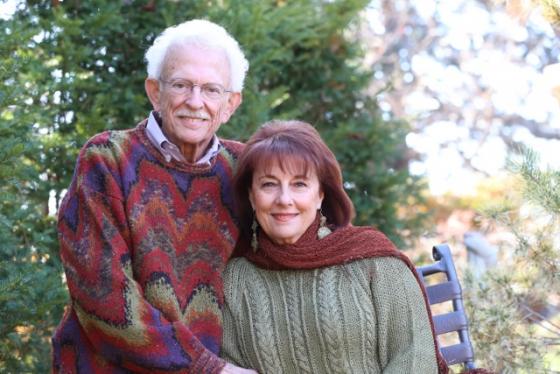Life as usual after spine surgery

Thomas Cooper can’t be sure where or when his back pain began. At age 77, Tom has lived a lifetime of demanding physical activity. It could have been related to 20 years of water skiing, high-intensity aerobic exercise, weight lifting or from years of bending and lifting in the yard, helping his wife, Ginny – an avid gardener. Whenever it flared up, a little physical therapy usually did the trick to calm it down again.
But this time was different. Tom and Ginny had just trimmed some trees in their backyard. Standing on an eight-foot ladder, Tom carefully balanced an electric tree trimmer on a pole that extended about 10 feet to saw a few remaining high branches. After about the fifth branch, Tom had to quit. The weight and awkwardness of holding the trimmer up had begun to put too much strain on his back.
Get it checked out. The Comprehensive Spine Program will help you schedule a timely appointment with the appropriate specialist. Call 800.922.0000.
Several days later, he remembers waking up to a lightning-like pain that began in his lower back and shot through his hip, down his leg into his left foot. “I’ll never forget it,” says Tom. “It was electrical pain – like fire and lightning. It was one of the worst pains I had ever felt."
_0.jpg)
A visit to his doctor and subsequent X-rays revealed no obvious answers. “He said my back was a mess with arthritis,” says Tom. “He knew it was being caused by something impinging on my nerve but he couldn’t pinpoint the source of my pain.” He referred him to a pain doctor who injected steroids in the general area to calm the pain.
“That helped for a about a week and then it was right back again,” recalls Tom. Thirty days later, a second shot was administered with the same result. He decided to see a spine specialist. His doctor referred him to Chris Cornett, MD, Nebraska Medicine orthopaedic surgeon with the Comprehensive Spine Program.
The Comprehensive Spine Program includes a team of specialists who work together to treat spine issues from the common to the complex, including congenital spine disorders, problems of the neck or back due to degeneration or traumatic injury. The team includes physical medicine and rehabilitation (PM&R) specialists, spine surgeons, pain specialists and physical and occupational therapists. Working together, the team can provide a more comprehensive and coordinated plan of care.
Spine surgeons at the Comprehensive Spine Program specialize in performing minimally invasive and image-guided complex spine procedures whenever possible. Minimally invasive techniques use smaller incisions, provide quicker recovery, shorter hospital stays and are tolerated well by most people.

After a thorough evaluation of Tom and his scans, Dr. Cornett discovered a small mass about the size of a grape on the side of Tom’s spine that was resting against a nerve. Since it was to the side of the spine, it would have been easy to miss by others. Dr. Cornett recommended injecting a steroid into the area to see if the pain subsided, which would help confirm that it was indeed the source of Tom’s pain. It worked – the pain subsided.
Surgery was scheduled at Nebraska Medical Center in January of this year to remove the mass and clean out the arthritic inflammation that had developed in the lower portion of Tom’s spine. Dr. Cornett performed a laminectomy, a procedure that involves removing some of the cartilage and bone between two of the vertebrae to create a space to reach the mass that was causing Tom’s pain. Once he was able to get through the spinal joint, Dr. Cornett followed the nerve root outside of the spine until he found the mass and carefully resected it. This was followed by a spinal fusion in which bone was fused between the adjacent vertebrae where the laminectomy was performed. A biopsy confirmed that it was a benign cyst.
“The procedure was a little complex as I had to find the cyst and once I did, I had to carefully resect it from the nerve root without damaging the nerve as this could have left him with weakness or numbness in his legs,” says Dr. Cornett.
Dr. Cornett emerged from the surgery room with a big smile on his face. “He told my wife, ‘it couldn’t have gone better,’” says Tom. “Every ounce of pain was gone from the moment I woke up from surgery.”
Tom was up and walking the same day of surgery and home the next day having dinner with his wife.
“The surgery went perfectly,” says Dr. Cornett. “All of our goals were accomplished. Tom’s pain is gone and he was able to go home the following day. Nationally, the average length of stay at a hospital after a surgery like this is four days or more. I pride myself in being able to discharge most of my patients within two days. This is possible for a number of reasons. First, I make sure we are doing the right surgery on the right patient and we do it well with efficiency, which decreases our operative times and blood loss. My team and I make sure our patients receive appropriate education before and after surgery, and we get our patients up and moving the day of surgery to help build strength and mobility instead of losing strength and mobility that comes from laying in a hospital bed for several days.”
Tom continues to undergo physical therapy to regain his muscle strength and agility. “Tom is doing well,” says Dr. Cornett. “He started in good shape and with a good attitude. Active patients almost always have a quicker recovery.”
As for his care at Nebraska Medical Center, Tom says it couldn’t have been better. “Dr. Cornett had my confidence from the beginning,” he says. “He was earnest and interested and made me feel comfortable. It was clear he knew what he was doing. About a week before surgery, a team of different doctors saw me and each asked very specific questions to make sure I was a good fit for surgery. I was very impressed.”
Tom says he is making great progress.” “I don’t see any reason why I can’t get back to where I left off but maybe next time I’ll leave the tree trimming to the professionals.”




